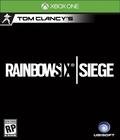I was in the audience when Ubisoft played the debut trailer for Rainbow Six Siege, and my first reaction was to marvel at how thoroughly they could destroy a single house. Randomly spraying gunfire through drywall, using a breaching charge to punch straight through a wooden floor, and shredding half of the second floor with a hail of bullets were all treated as valid gameplay tactics, which is one of those things that doesn't show up in games as often as you'd think.
As it turns out, a demo level of Siege was available on the E3 2014 show floor, and the general idea stands. Destruction is a "gameplay tool," according to the developers, in a game that's focused squarely on multiplayer. One team, the Rainbows, AKA Raven Shield, is tasked with infiltrating an enemy stronghold and rescuing a hostage; the other team, the Enemies, AKA Rogue Spear, would prefer to keep that hostage. The Rainbows can win by wiping out the other team or escorting the hostage to an evacuation point, while the enemy team wins by repelling the Rainbows' assault.
At the start of a round, both sides have a full minute to prepare for the imminent attack. The setting for the demo level was what you saw in the Ubisoft trailer: a two-story suburban home with a basement and some tasteful, expensive furniture. In that opening minute, the Rainbows can rappel up walls or get to the roof while using small camera-bearing drones to investigate the house. These drones are small enough to slide under most doors and provide a black-and-white, real-time image of what the other team's doing and, ideally, where they're keeping the hostage. They're also destructible, so if an enemy sees them, they can shoot them and remove them from play.
The enemy team, meanwhile, has the option to fortify the house against attack by deciding where they're going to stash the hostage and setting up defenses accordingly. You can keep track of the other team's actions via a network of closed-circuit cameras built into the house, which lets you watch windows for movement and get an early idea of which direction the Rainbows' assault is going to come from.
Each player on this team has up to two barricades they can place, which are destructible wooden frames that can be placed across doorways to prevent entry; you can even knock a hole in one of them to provide a handy gunport. White walls can be reinforced to prevent infiltrators from going through them as easily, and you can place bulletproof shields at various chokepoints to give yourself some heavy cover. Another option is to place barbed wire, which does no actual damage to anyone going through it but slows them down considerably, setting them up for an attack; or to plant explosives like nitro cells, which can be used as a trap or as an improvised grenade.
Both sides have access to character classes such as the Assaulter, Breacher and Pointman, which have access to different equipment and abilities. One class starts a match with a transparent riot shield, ensuring you always have cover, while another gets access to better explosives.
Once the actual fight starts, things get dangerous. As with past Rainbow Six games, Siege does not place a high value on individual lives, and one stray burst of gunfire is enough to permanently remove a player from a match. Whoever gets seen first tends to be the one who loses an exchange, and both the drones and the network of security cameras allow you to find and attack an opponent from relative safety by shooting straight through the walls. A player who gets killed is down for the rest of the match, and a single player could take out an entire team on his own with the right approach and weapon, so the game is a tense, vicious experience from the start.
Success virtually requires coordination, planning, and cooperation, which means this game is likely to be fun and rewarding with a team of like-minded players, and a complete mess if you're trying to play it with four random strangers over Xbox Live or something.
(You could really see this in effect in the behind-closed-doors demo. When Ubisoft's team took control, they were calm, polite, complimentary toward one another, and ruthlessly efficient, using breaching charges, flashbangs, and fields of fire to their best advantage. When we idiot journalists took control, it was like watching small children play with automatic weapons. Rainbow Six, everybody.)
The terrorists-vs.-counterterrorists angle is old hat by this point, but the tactical aspect of Rainbow Six Siege is the interesting part, as well as the destructible environments. Once we start seeing more maps and more of both teams' available toys — I was told that the demo was just the tip of the iceberg as far as cool spy gear went – it's possible this could be a return to form for the series. Of course, that "form" has always been a few calm professionals ruthlessly cutting down a small legion of twitch-gamer Halo fans like wheat before the scythe, but that's part of the Rainbow Six appeal.
More articles about Tom Clancy's Rainbow Six Siege











 Inspired by real world counter-terrorist organizations, Tom Clancy's Rainbow Six Siege puts players in the middle of lethal close-quarters confrontations.
Inspired by real world counter-terrorist organizations, Tom Clancy's Rainbow Six Siege puts players in the middle of lethal close-quarters confrontations.



